Martin Bauer
@martinmbauer.bsky.social
I'm a theoretical physicist at Durham University
The SM as realised in nature corresponds to a very special trajectory in this theory space
It stays for very long RG-time almost on the scaleless trajectory only to branch off into the broken phase
9/ 11
It stays for very long RG-time almost on the scaleless trajectory only to branch off into the broken phase
9/ 11

October 25, 2025 at 3:31 PM
The SM as realised in nature corresponds to a very special trajectory in this theory space
It stays for very long RG-time almost on the scaleless trajectory only to branch off into the broken phase
9/ 11
It stays for very long RG-time almost on the scaleless trajectory only to branch off into the broken phase
9/ 11
But there're different low energy fixed points.
They correspond to the three different options for the Higgs mass term mu^2<0, mu^2=0 and mu^2>0
The mu^2>0 branch corresponds to the SM in which the electroweak gauge symmetry remains unbroken
6/11
They correspond to the three different options for the Higgs mass term mu^2<0, mu^2=0 and mu^2>0
The mu^2>0 branch corresponds to the SM in which the electroweak gauge symmetry remains unbroken
6/11

October 25, 2025 at 3:31 PM
But there're different low energy fixed points.
They correspond to the three different options for the Higgs mass term mu^2<0, mu^2=0 and mu^2>0
The mu^2>0 branch corresponds to the SM in which the electroweak gauge symmetry remains unbroken
6/11
They correspond to the three different options for the Higgs mass term mu^2<0, mu^2=0 and mu^2>0
The mu^2>0 branch corresponds to the SM in which the electroweak gauge symmetry remains unbroken
6/11
In the 'map of theories', this is a fixed point. Because it doesn't matter what the values if the mass parameters of the theory were different, in the limit of very high energies, physical observables would all look the same
3/11
3/11

October 25, 2025 at 3:31 PM
In the 'map of theories', this is a fixed point. Because it doesn't matter what the values if the mass parameters of the theory were different, in the limit of very high energies, physical observables would all look the same
3/11
3/11
The hierarchy problem (finetuning) of the Standard Model of particle physics is often presented as the question 'why the weak scale is so much smaller than the Planck scale'
But there is also a geometric interpretation that can be understood with little maths (but a lot of physics)
🧵1/11
But there is also a geometric interpretation that can be understood with little maths (but a lot of physics)
🧵1/11

October 25, 2025 at 3:31 PM
The hierarchy problem (finetuning) of the Standard Model of particle physics is often presented as the question 'why the weak scale is so much smaller than the Planck scale'
But there is also a geometric interpretation that can be understood with little maths (but a lot of physics)
🧵1/11
But there is also a geometric interpretation that can be understood with little maths (but a lot of physics)
🧵1/11
In superconductors you can build have states where many, many Cooper pairs (pairs of electrons) are described by the same wavefunction, which allows them collectively to tunnel through thin insulator barriers called Josephson junctions
6/7
6/7

October 8, 2025 at 8:17 PM
In superconductors you can build have states where many, many Cooper pairs (pairs of electrons) are described by the same wavefunction, which allows them collectively to tunnel through thin insulator barriers called Josephson junctions
6/7
6/7
It is also responsible for field electron emission, used in electron microscopes and tunnel diodes, nuclear fusion in stars, etc
4/7
4/7

October 8, 2025 at 8:17 PM
It is also responsible for field electron emission, used in electron microscopes and tunnel diodes, nuclear fusion in stars, etc
4/7
4/7
This effect isn't uncommon in nature
It explains radioactive alpha-decay where a whole Helium nucleus is emitted from a heavy decaying element even if the binding forces wouldn't allow this process classically
3/7
It explains radioactive alpha-decay where a whole Helium nucleus is emitted from a heavy decaying element even if the binding forces wouldn't allow this process classically
3/7

October 8, 2025 at 8:17 PM
This effect isn't uncommon in nature
It explains radioactive alpha-decay where a whole Helium nucleus is emitted from a heavy decaying element even if the binding forces wouldn't allow this process classically
3/7
It explains radioactive alpha-decay where a whole Helium nucleus is emitted from a heavy decaying element even if the binding forces wouldn't allow this process classically
3/7
..is on the other side of the barrier (unless its an infinitely strong force field)
If you measure the position of the particle there is a finite probability it's outside the trap even if it never had enough kinetic energy to overcome the barrier. It 'tunnels' through the barrier
2/7
If you measure the position of the particle there is a finite probability it's outside the trap even if it never had enough kinetic energy to overcome the barrier. It 'tunnels' through the barrier
2/7

October 8, 2025 at 8:17 PM
..is on the other side of the barrier (unless its an infinitely strong force field)
If you measure the position of the particle there is a finite probability it's outside the trap even if it never had enough kinetic energy to overcome the barrier. It 'tunnels' through the barrier
2/7
If you measure the position of the particle there is a finite probability it's outside the trap even if it never had enough kinetic energy to overcome the barrier. It 'tunnels' through the barrier
2/7
Short explanation of the physics Nobel Prize 2025
In classical mechanics you can know where a particle is and its momentum at the same time. In Quantum mechanics you can't. All information is in the wavefunction. Even if a particle is trapped, part of the wavefunction..
🧵1/7
In classical mechanics you can know where a particle is and its momentum at the same time. In Quantum mechanics you can't. All information is in the wavefunction. Even if a particle is trapped, part of the wavefunction..
🧵1/7

October 8, 2025 at 8:17 PM
Short explanation of the physics Nobel Prize 2025
In classical mechanics you can know where a particle is and its momentum at the same time. In Quantum mechanics you can't. All information is in the wavefunction. Even if a particle is trapped, part of the wavefunction..
🧵1/7
In classical mechanics you can know where a particle is and its momentum at the same time. In Quantum mechanics you can't. All information is in the wavefunction. Even if a particle is trapped, part of the wavefunction..
🧵1/7
This night 102 years ago, Hubble discovered that there're stars outside our galaxy by observing a Cepheid variable star 1 million light years away
Until barely a century ago, no human ever knew whether there was more than one galaxy in the Universe. Think about that!
Until barely a century ago, no human ever knew whether there was more than one galaxy in the Universe. Think about that!

October 5, 2025 at 7:45 PM
This night 102 years ago, Hubble discovered that there're stars outside our galaxy by observing a Cepheid variable star 1 million light years away
Until barely a century ago, no human ever knew whether there was more than one galaxy in the Universe. Think about that!
Until barely a century ago, no human ever knew whether there was more than one galaxy in the Universe. Think about that!
These results use Run 2 data. By the end of Run 4, the much larger dataset would push the significance beyond discovery thresholds, if the central value holds
In the plot below we were at the blue, we are now at the red and could be as sensitive as the green markers
6/6
In the plot below we were at the blue, we are now at the red and could be as sensitive as the green markers
6/6

September 9, 2025 at 6:48 PM
These results use Run 2 data. By the end of Run 4, the much larger dataset would push the significance beyond discovery thresholds, if the central value holds
In the plot below we were at the blue, we are now at the red and could be as sensitive as the green markers
6/6
In the plot below we were at the blue, we are now at the red and could be as sensitive as the green markers
6/6
If it is indeed physics beyond the standard model, the data points toward the same types of interactions that have already been shown to consistently explain several other anomalies in B-meson decays
4/6
4/6

September 9, 2025 at 6:48 PM
If it is indeed physics beyond the standard model, the data points toward the same types of interactions that have already been shown to consistently explain several other anomalies in B-meson decays
4/6
4/6
The statistical significance is 4.1 standard deviations.
Intriguingly, CMS, another experiment at the Large Hadron Collider, has also measured this process and sees the same anomaly, too
2/6
Intriguingly, CMS, another experiment at the Large Hadron Collider, has also measured this process and sees the same anomaly, too
2/6

September 9, 2025 at 6:48 PM
The statistical significance is 4.1 standard deviations.
Intriguingly, CMS, another experiment at the Large Hadron Collider, has also measured this process and sees the same anomaly, too
2/6
Intriguingly, CMS, another experiment at the Large Hadron Collider, has also measured this process and sees the same anomaly, too
2/6
Today LHCb presented a new measurement of the decay of a B meson into a K* and a μ+ μ- pair
Previous results disagreed with the Standard Model prediction for the branching fraction and angular distribution
The new measurement has almost twice as much data and still disagrees!
🧵1/6
Previous results disagreed with the Standard Model prediction for the branching fraction and angular distribution
The new measurement has almost twice as much data and still disagrees!
🧵1/6

September 9, 2025 at 6:48 PM
Today LHCb presented a new measurement of the decay of a B meson into a K* and a μ+ μ- pair
Previous results disagreed with the Standard Model prediction for the branching fraction and angular distribution
The new measurement has almost twice as much data and still disagrees!
🧵1/6
Previous results disagreed with the Standard Model prediction for the branching fraction and angular distribution
The new measurement has almost twice as much data and still disagrees!
🧵1/6
And if you consider the limit of x_1 -> x_2 you can see how the Pauli principle follows for fermions
14/14
14/14

August 1, 2025 at 9:32 PM
And if you consider the limit of x_1 -> x_2 you can see how the Pauli principle follows for fermions
14/14
14/14
In 2D this can be any complex number with a different phase factor for each winding number. In 3D+ it can be only +1 or -1
12/
12/

August 1, 2025 at 9:32 PM
In 2D this can be any complex number with a different phase factor for each winding number. In 3D+ it can be only +1 or -1
12/
12/
In Quantum mechanics the question is how does the wavefunction describing two identical particles transform under this exchange. This corresponds to an operator O(\lambda) with is a 1-dimensional unitary representation of the fundamental group acting on the WF
11/
11/

August 1, 2025 at 9:32 PM
In Quantum mechanics the question is how does the wavefunction describing two identical particles transform under this exchange. This corresponds to an operator O(\lambda) with is a 1-dimensional unitary representation of the fundamental group acting on the WF
11/
11/
So the fundamental group of the configuration space in 3D+ is the group with exactly 2 elements
10/
10/
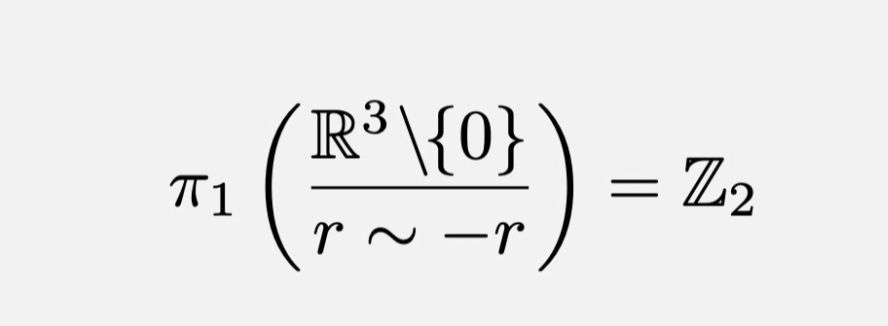
August 1, 2025 at 9:32 PM
So the fundamental group of the configuration space in 3D+ is the group with exactly 2 elements
10/
10/
Here is a representation of a non-contractible loop that can't be continuously transformed into a point
9/
9/

August 1, 2025 at 9:32 PM
Here is a representation of a non-contractible loop that can't be continuously transformed into a point
9/
9/
Here is a representation of how the contractible loop can be continuously transformed into a point (=no exchange of the two particles)
Again, the bar on the right part is the line connecting the two particles
8/14
Again, the bar on the right part is the line connecting the two particles
8/14

August 1, 2025 at 9:32 PM
Here is a representation of how the contractible loop can be continuously transformed into a point (=no exchange of the two particles)
Again, the bar on the right part is the line connecting the two particles
8/14
Again, the bar on the right part is the line connecting the two particles
8/14
And closing the q2 loop twice is equivalent to a contractible loop
7/14
7/14

August 1, 2025 at 9:32 PM
And closing the q2 loop twice is equivalent to a contractible loop
7/14
7/14
Here, there're only 2 different classes of loops that can't be transformed into each other. Contractible loops (q1) and non-contractible loops (q2)
6/14
6/14
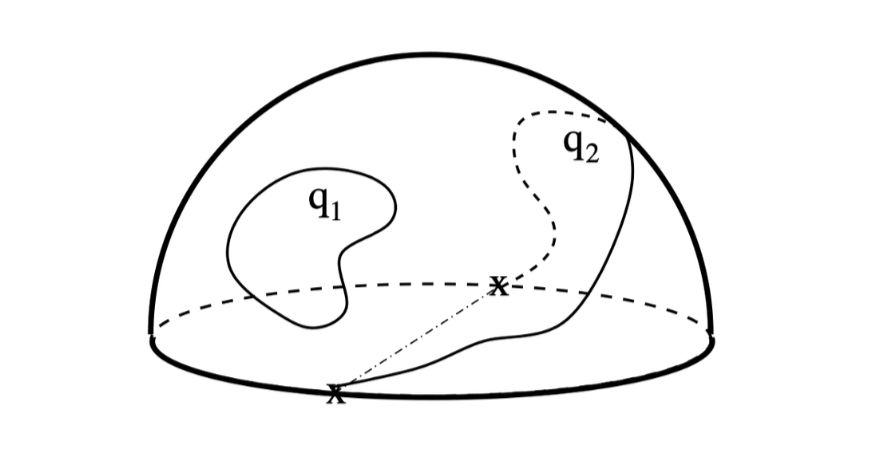
August 1, 2025 at 9:32 PM
Here, there're only 2 different classes of loops that can't be transformed into each other. Contractible loops (q1) and non-contractible loops (q2)
6/14
6/14
Now in 3D (or higher) the situation is different. Here, the configuration space is a half sphere, or a disk with opposite points identified
5/14
5/14
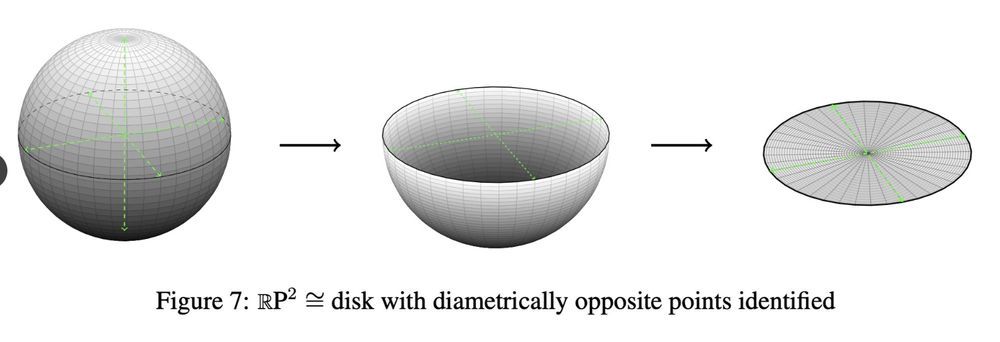
August 1, 2025 at 9:32 PM
Now in 3D (or higher) the situation is different. Here, the configuration space is a half sphere, or a disk with opposite points identified
5/14
5/14
The different classes of such loops that can't be transformed into each other by stretching and moving them around the cone (w/o a tip) form the first fundamental group of the configuration space
While R^2 is simply connected (every loop can be contracted to a dot), this space is not
4/14
While R^2 is simply connected (every loop can be contracted to a dot), this space is not
4/14
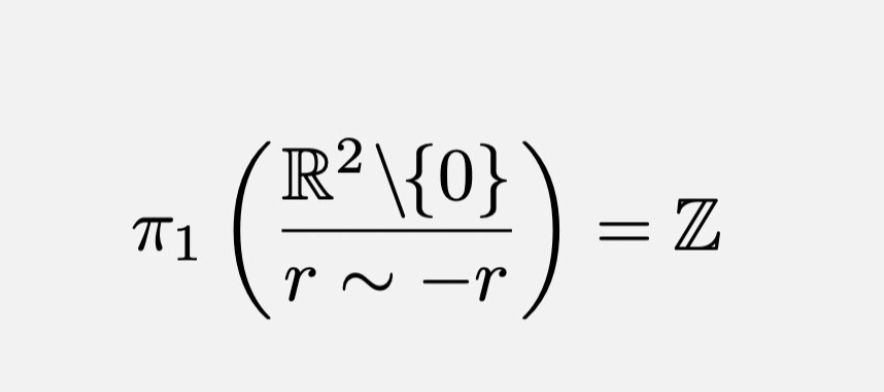
August 1, 2025 at 9:32 PM
The different classes of such loops that can't be transformed into each other by stretching and moving them around the cone (w/o a tip) form the first fundamental group of the configuration space
While R^2 is simply connected (every loop can be contracted to a dot), this space is not
4/14
While R^2 is simply connected (every loop can be contracted to a dot), this space is not
4/14
Any exchange of these two particles corresponds to a loop on this cone
Two loops that can be continually transformed into each other are equivalent. But because the tip of the cone is missing, any number of rotations around the cone can't be transformed into one with fewer or more windings
3/14
Two loops that can be continually transformed into each other are equivalent. But because the tip of the cone is missing, any number of rotations around the cone can't be transformed into one with fewer or more windings
3/14
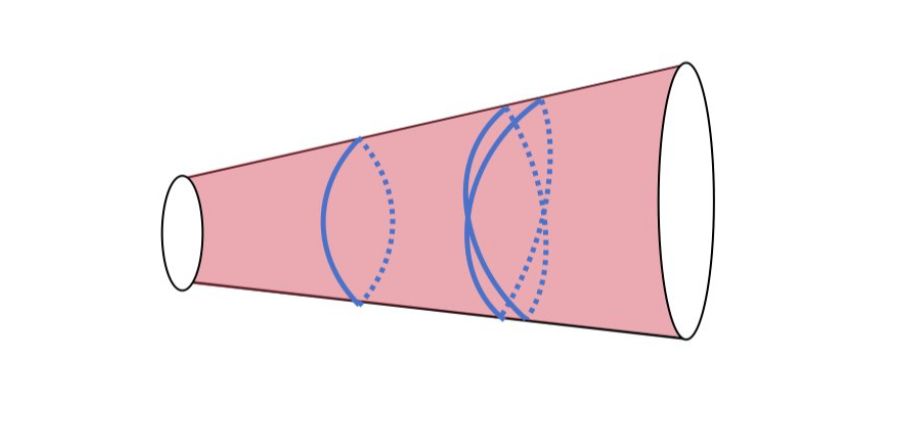
August 1, 2025 at 9:32 PM
Any exchange of these two particles corresponds to a loop on this cone
Two loops that can be continually transformed into each other are equivalent. But because the tip of the cone is missing, any number of rotations around the cone can't be transformed into one with fewer or more windings
3/14
Two loops that can be continually transformed into each other are equivalent. But because the tip of the cone is missing, any number of rotations around the cone can't be transformed into one with fewer or more windings
3/14

